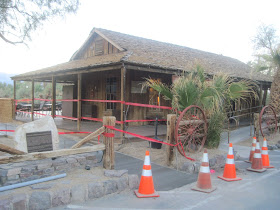Part of our enjoyment in driving through Death Valley National Park was found in seeing the many contrasting landscapes. After driving through miles of dry rocky land it was a bit refreshing to see an oasis where there are plants and trees. The picture above was taken at Furnace Creek Inn. Furnace Creek is a spring-fed stream flowing into Death Valley. The valley gets two inches of rain a year so streams like Furnace Creek are quite important. In 1881 borax was discovered in this area and a ranch was constructed to support borax workmen as well as the twenty-mule teams. The ranch later became a guesthouse and now is a museum. Built in 1883, it is the oldest structure in the valley.
Our last stop of the day was at the Harmony Borax Works. Here we took an interpretive trail around original mule team wagons (the wagon at the end is a water tank), and the ruins of the mine processing plant.
Chinese laborers scraped the borax off the flats and then hauled it by wagons to the refining plant. There the borax was washed from unwanted mud and salts. I was in error when previously I indicated that 20 million pounds of ore were hauled out in two wagons at a time- rather that amount was the total hauled out of the valley by mule teams from 1883-1889. My thanks goes to a reader who caught that error! Over a period of 150 years borax, gold and other metals have been mined in Death Valley. The valley's last active mine was closed in 2005. Borax, or the "White Gold of the Desert", has proven to be the valley's most profitable mineral. By the time we toured the old borax mine the sun was setting and it was time to head home.



No comments:
Post a Comment